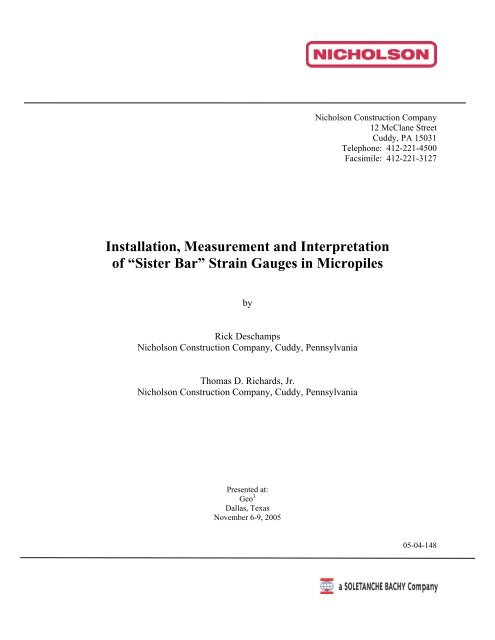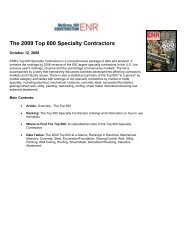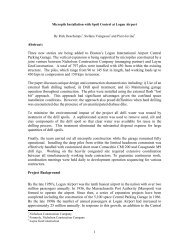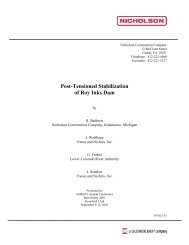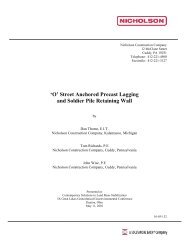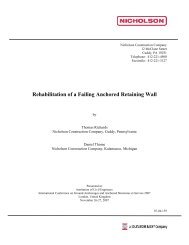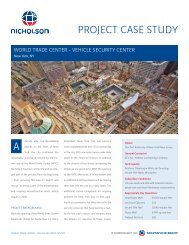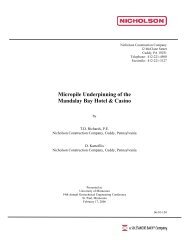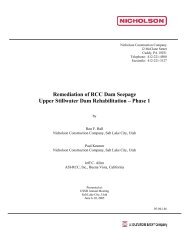Strain Gauges in Micropiles - Nicholson Construction Company
Strain Gauges in Micropiles - Nicholson Construction Company
Strain Gauges in Micropiles - Nicholson Construction Company
- No tags were found...
Create successful ePaper yourself
Turn your PDF publications into a flip-book with our unique Google optimized e-Paper software.
<strong>Nicholson</strong> <strong>Construction</strong> <strong>Company</strong>12 McClane StreetCuddy, PA 15031Telephone: 412-221-4500Facsimile: 412-221-3127Installation, Measurement and Interpretationof “Sister Bar” <strong>Stra<strong>in</strong></strong> <strong>Gauges</strong> <strong>in</strong> <strong>Micropiles</strong>byRick Deschamps<strong>Nicholson</strong> <strong>Construction</strong> <strong>Company</strong>, Cuddy, PennsylvaniaThomas D. Richards, Jr.<strong>Nicholson</strong> <strong>Construction</strong> <strong>Company</strong>, Cuddy, PennsylvaniaPresented at:Geo 3Dallas, TexasNovember 6-9, 200505-04-148
AbstractINSTALLATION, MEASUREMENT, AND INTERPRETATIONOF "SISTER BAR" STRAIN GAUGES IN MICROPILESRick Deschamps 1 and Thomas D Richards, Jr. 2"Sister bar" stra<strong>in</strong> gauges provide a cost effective and practical means of verify<strong>in</strong>g thelocation of load transfer <strong>in</strong> micropiles. This paper provides a general overviewregard<strong>in</strong>g the use of stra<strong>in</strong> gauges for <strong>in</strong>terpretation of micropile performance. Topicscovered <strong>in</strong>clude: pert<strong>in</strong>ent applications, comparison to tell-tales, available equipment,<strong>in</strong>stallation, measurement, and <strong>in</strong>terpretation. Emphasis is placed on illustrat<strong>in</strong>g theuse of stra<strong>in</strong> measurements to determ<strong>in</strong>e actual load transfer with<strong>in</strong> the pile, <strong>in</strong>clud<strong>in</strong>greconciliation with pile head measurements of displacement and load. Specificexamples are used to highlight key po<strong>in</strong>ts <strong>in</strong> the <strong>in</strong>terpretation process, <strong>in</strong>clud<strong>in</strong>gtransitions <strong>in</strong> ground strata and pile cross-sections, and <strong>in</strong> identify<strong>in</strong>g poor data.IntroductionIt is generally desirable to understand the distribution of load transfer between pile andground dur<strong>in</strong>g a load test <strong>in</strong> order to assess the performance of the designedfoundation system. Load transfer has historically been <strong>in</strong>ferred by use of telltales, orthrough the use of stra<strong>in</strong> gauges. In the case of micropiles, "sister bar" stra<strong>in</strong> gaugeshave several advantages <strong>in</strong>clud<strong>in</strong>g accuracy, low cost, and relative ease of use. Thispaper provides a broad overview of their use and provides details on a specificapplication.Pert<strong>in</strong>ent ApplicationsThe primary objective when <strong>in</strong>stall<strong>in</strong>g stra<strong>in</strong> gauges is to understand how the load isbe<strong>in</strong>g distributed to the ground along the length of the pile. A few specific cases whenthis <strong>in</strong>formation is relevant <strong>in</strong>clude:1. Confirmation that design load is carried <strong>in</strong> targeted bond zone,2. Measure the depth of load transfer with<strong>in</strong> the bond zone <strong>in</strong> order to assess ofbond lengths can be shortened.3. Measur<strong>in</strong>g the true load on piles after construction4. Understand<strong>in</strong>g the differences <strong>in</strong> short term (undra<strong>in</strong>ed) and long term(dra<strong>in</strong>ed) load transfer characteristics,5. Accurate estimation of deformation under load.1 Head of Eng<strong>in</strong>eer<strong>in</strong>g, and 2 Chief Eng<strong>in</strong>eer, <strong>Nicholson</strong> <strong>Construction</strong>, 12 McClaneStreet, Cuddy, PA 15031; rdeschamps@nicholsonconstruction.com andtrichards@nicholsonconstruction.com
Comparison to Tell-talesHistorically, load transfer <strong>in</strong>terpretations where made with the use of "telltales," wherea telltale is a small diameter stiff bar that is encased <strong>in</strong> a tube and attached to the pileat a strategic location. Vertical movement of the bar is an <strong>in</strong>dication of load transfer atthe po<strong>in</strong>t of attachment. The magnitude of load transfer can be <strong>in</strong>ferred fromdifferences <strong>in</strong> relative movements of the pile head and <strong>in</strong>dividual telltales, by mak<strong>in</strong>gidealized assumptions regard<strong>in</strong>g the load transfer (or stra<strong>in</strong>) distribution. Telltales canbe an effective tool provided that they are <strong>in</strong>stalled properly, that they are not damageddur<strong>in</strong>g pile construction/<strong>in</strong>stallation, and that the subsurface profile can be sufficientlyidealized to allow reliable <strong>in</strong>terpretation of the data. In general, many <strong>in</strong>stalledtelltales do not function properly such that the data available for load transfer<strong>in</strong>terpretation is limited.Unlike telltales where the average stra<strong>in</strong> is measured between the pile head and thetelltale or between two telltales, a stra<strong>in</strong> gauge measures stra<strong>in</strong> locally. Accord<strong>in</strong>gly,the load <strong>in</strong> the pile at the location of the stra<strong>in</strong> gauge can be estimated directly,provided the composite modulus of the pile is known accurately. For some pile types,<strong>in</strong>clud<strong>in</strong>g micropiles, the pile modulus can not be calculated accurately based ongeometry and assumed material properties; it must be measured. This is true becauseof natural variability of grout modulus due to: changes with time, non-l<strong>in</strong>earity withstress level, and variation with degree of conf<strong>in</strong>ement.Available EquipmentUntil recent years the stra<strong>in</strong> gauges employed were typically th<strong>in</strong> electrical resistancebased gauges that were glued onto a pile component at the desired location. Thegauges function by not<strong>in</strong>g small changes <strong>in</strong> resistance that occur with gaugeelongation and the correlation with stra<strong>in</strong>. The challenge was to <strong>in</strong>stall the gauges sothat they would not be damaged as part of the <strong>in</strong>stallation/construction process. Also,the gauges and wires do have to be kept dry because moisture changes the electricalresistance and thus the measured resistance and <strong>in</strong>terpreted stra<strong>in</strong>. In the case ofmicropiles, which are drilled <strong>in</strong> elements, there is limited chance of success for stra<strong>in</strong>gauges that are glued to the cas<strong>in</strong>g. Furthermore, glu<strong>in</strong>g the stra<strong>in</strong> gauges to there<strong>in</strong>forcement bars is not straight forward requir<strong>in</strong>g gr<strong>in</strong>d<strong>in</strong>g a flat surface on thethreaded rods and significant risk of damage dur<strong>in</strong>g <strong>in</strong>stallation.A sister bar stra<strong>in</strong> gauge is a robust embedded <strong>in</strong>strument that consists of a vibrat<strong>in</strong>gwire stra<strong>in</strong> gauge mounted on a length of steel rebar as shown <strong>in</strong> Figure 1. The basisfor stra<strong>in</strong> measurement is a wire under tension is clamped at both ends so that it canvibrate freely. Similar to a guitar str<strong>in</strong>g, the higher the tension <strong>in</strong> the wire, the higherthe natural frequency of vibration. <strong>Stra<strong>in</strong></strong> <strong>in</strong> compression reduces the distance betweenthe clamps and thereby reduces the natural frequency of the wire. Read<strong>in</strong>gs are takenby pluck<strong>in</strong>g the wire magnetically with an electric coil. The same coil (or anotherone) also measures the vibrat<strong>in</strong>g frequency. Through calibration there is a l<strong>in</strong>earrelationship between wire frequency and transducer stra<strong>in</strong>. As with resistance stra<strong>in</strong>gauges, a wire is used to transmit an electric current to the gauge and to return asignal, which is delivered to a readout box or data logger (see Figure 2). However,s<strong>in</strong>ce the measurement is frequency of vibration of a wire, it is not affected by
moisture or wire length. This is most evident when the gauge is read <strong>in</strong> the air andthen placed <strong>in</strong> water and read aga<strong>in</strong>.Figure 1 Sister Bar <strong>Stra<strong>in</strong></strong> <strong>Gauges</strong>Figure 2 Datalogger and MultiplexerPlann<strong>in</strong>g and Location of <strong>Gauges</strong>Cost and pragmatics limit the number of stra<strong>in</strong> gauges that can be used. Accord<strong>in</strong>gly,it is necessary to position the <strong>in</strong>struments strategically <strong>in</strong> order to obta<strong>in</strong> the desireddata. Generally, the <strong>in</strong>struments are used to assess the applicability of the modelemployed <strong>in</strong> the design analysis. In most micropile applications the objectives are todemonstrate that the load is be<strong>in</strong>g transmitted to the bond zone and to verify thereduction <strong>in</strong> load with<strong>in</strong> the bond zone. Accord<strong>in</strong>gly, it is common to concentrate thestra<strong>in</strong> gauges <strong>in</strong> this zone. However, it is important to place additional gauges at thepile head to measure the composite modulus of the pile.
Typical layout of the gauges is shown <strong>in</strong> Figure 3 and described as follows:1. Two gauges 3 to 5 feet below the top ofthe pile to measure composite modulus andtwo average out bend<strong>in</strong>g,2. Just above the bond zone to record the loadthat is gett<strong>in</strong>g to the bond zone,3. With<strong>in</strong> the upper few feet of the bond zoneand below the typical change <strong>in</strong>re<strong>in</strong>forcement ( often no cas<strong>in</strong>g <strong>in</strong> bondzone),4. Midway <strong>in</strong> the bond zone to assess loaddistribution and to assess actual bondstresses for possible redesign of the pile ifdesired,5. Near the bottom of the pile to determ<strong>in</strong>ehow much (if any) load is be<strong>in</strong>g transferred<strong>in</strong> end bear<strong>in</strong>g.<strong>Stra<strong>in</strong></strong><strong>Gauges</strong>The reason for two gauges at the top are to averageout bend<strong>in</strong>g stra<strong>in</strong> caused by imperfect load<strong>in</strong>g.These gauges need to be placed equidistantly fromthe centerl<strong>in</strong>e of the pile and preferably on the sidesof the pile perpendicular to the axis of the testbeam, which is the most likely direction of bend<strong>in</strong>g.The gauges at the top of the pile should be farenough from the end of the pile to m<strong>in</strong>imize nonuniform stra<strong>in</strong> distribution, while be<strong>in</strong>g closeenough to measure the applied load. Pairs ofgauges at depth are often not used because thebend<strong>in</strong>g at depth is m<strong>in</strong>imal.BondZoneFigure 3. Typical stra<strong>in</strong> gaugelayout.The reason for a gauge near the top of bond zone is that the pile section, especially thearea of steel, often changes <strong>in</strong> the bond zone. When plann<strong>in</strong>g the location of the stra<strong>in</strong>gauge, the length of the sister bar must be considered to keep the bar length <strong>in</strong> thesame section of pile and avoid cas<strong>in</strong>g jo<strong>in</strong>ts.When order<strong>in</strong>g the gauges, <strong>in</strong>form the gauge manufacturer whether you <strong>in</strong>tend to loadthe pile and gauges <strong>in</strong> compression or tension and the estimated stra<strong>in</strong>s for each case.This will allow the proper selection of gauge with a more appropriate vibration rangefor the test be<strong>in</strong>g conducted.InstallationFor micropiles, the rebar and mounted gauges are typically tied to the threadedre<strong>in</strong>forc<strong>in</strong>g bar(s) and lowered <strong>in</strong>to position. Care must be exercised not to damagethe wires dur<strong>in</strong>g or after <strong>in</strong>stallation and arrangements must be made to pass thewir<strong>in</strong>g through the cas<strong>in</strong>g or bear<strong>in</strong>g plate.
Precautions that should be taken dur<strong>in</strong>g <strong>in</strong>stallation <strong>in</strong>clude:• Label all wires ( most <strong>in</strong>strument manufacturers assign a serial number to eachgauge and provide a label of the serial number on the wire)• Do not proceed without the special vibrat<strong>in</strong>g wire gauge measurement unit(typically the readout box) and be sure to have the readout box <strong>in</strong> the propersett<strong>in</strong>g,• Read the gauges as delivered and compare read<strong>in</strong>gs to factory zero read<strong>in</strong>gs,• Layout the gauges on the bar at the desired location,• Modify the gauge locations as necessary with the as-built pile. Try to place thebar <strong>in</strong> the same cross section of the pile and avoid alignment with cas<strong>in</strong>g jo<strong>in</strong>ts.• Note the gauge serial number and as-built location ,• Zip tie or duct tape the read<strong>in</strong>g wires to the sister bar with a little slack <strong>in</strong> thecable us<strong>in</strong>g care to not cut the wire. This will avoid pull<strong>in</strong>g on at thewire/gauge connection.• Tiewire the gauges to the pile re<strong>in</strong>forc<strong>in</strong>g bar and read aga<strong>in</strong> and compare tofactory zero,• Modify centralizer locations near the gauge (do not let centralizer locationchange the target location of the gauge),• While plac<strong>in</strong>g the pile re<strong>in</strong>forc<strong>in</strong>g bar down the pile, zip tie or duct tape theread<strong>in</strong>g wires to the bar us<strong>in</strong>g care to not cut the wire and not allow bulges <strong>in</strong>the wires that could get cut at p<strong>in</strong>ch po<strong>in</strong>ts (bar couplers or cas<strong>in</strong>g threads),• Use plenty of bar centralizers and run the wires through the centralizers, not onthe outer edge of the centralizers• Do not cut the wires without relabell<strong>in</strong>g which gauge serial number on thewire,• Obta<strong>in</strong> read<strong>in</strong>gs <strong>in</strong>itially after gauge placement and grout<strong>in</strong>g, dur<strong>in</strong>g grouthydration, and after grout is hard,• Prior to test<strong>in</strong>g, put a nut on the bar with the upper face <strong>in</strong> the plane of thecas<strong>in</strong>g edge, fill the entire annulus with grout and place the bear<strong>in</strong>g plate ontop. This will improve the even load<strong>in</strong>g of the <strong>in</strong>ner rod, the grout and thecas<strong>in</strong>g and the evaluation of composite modulus. This is discussed furtherbelow regard<strong>in</strong>g Figure 7.Most manufacturers’ literature recommend aga<strong>in</strong>st hang<strong>in</strong>g the sister bars from theelectrical wire. However, <strong>in</strong> piles without a central bar, we have successfully <strong>in</strong>sertedthe gauges after neat cement grout<strong>in</strong>g by duct-tap<strong>in</strong>g the wire to the sister bars (toavoid tension at the connection), then lower<strong>in</strong>g with the wire ( See Figure 1) andhang<strong>in</strong>g the sister bar from the wire.Most gauges also have a temperature sensor. It is <strong>in</strong>terest<strong>in</strong>g to see how hot the groutgets. On one project, the grout <strong>in</strong>side 7 <strong>in</strong>ch cas<strong>in</strong>g reached a temperature of over 100deg C and gauges appeared to have functioned fairly well dur<strong>in</strong>g the load test.MeasurementThe stra<strong>in</strong> gauges arrive factory calibrated. <strong>Stra<strong>in</strong></strong> read<strong>in</strong>gs can be recorded manuallyus<strong>in</strong>g a digital readout unit or automatically with a data logger. The stra<strong>in</strong> gauges aretypically connected to a junction box. For manual read<strong>in</strong>gs, a switch box can be usedto read each gauge sequentially us<strong>in</strong>g the digital readout unit. Alternatively, the data
logger cycles through each of the stra<strong>in</strong> gauges and takes read<strong>in</strong>gs at preset time<strong>in</strong>tervals or with computer keystrokes after some datalogger programm<strong>in</strong>g. Thesetime <strong>in</strong>tervals are synchronized with the pile load<strong>in</strong>g sequence. These components areshown <strong>in</strong> Figure 2.The gauges measure stra<strong>in</strong> relative to some arbitrary "zero" stra<strong>in</strong> condition. Usually,the zero condition is taken to be the read<strong>in</strong>gs just prior to the application of load on thepile, after the gauge has acclimated to the stress and temperature conditions for the asconstructed condition. All stra<strong>in</strong>s, and therefore loads, are assumed to be relative tothis base condition. However, it is important to obta<strong>in</strong> background read<strong>in</strong>gs andevaluate the change <strong>in</strong> stra<strong>in</strong> between <strong>in</strong>stallation and test<strong>in</strong>g.Interpretation<strong>Stra<strong>in</strong></strong> measurements are obta<strong>in</strong>ed at the location of each gauge at specific loads andtimes. In general, the objective is to acquire loads <strong>in</strong> the piles at these locations. Therelationship used to estimate local load <strong>in</strong> the pile is as follows:Where:∆LσaPεa= = =(1)L E AEε a∆LLσ aEPA= Axial stra<strong>in</strong>= Change <strong>in</strong> length= Length= Axial Stress (average)= Young's Modulus (average)= Force <strong>in</strong> pile= Cross-sectional areaRearrang<strong>in</strong>g Eqn. (1)P = AEε(2)aAccord<strong>in</strong>gly, it is necessary to estimate the average Young's modulus <strong>in</strong> order toestimate the pile load from stra<strong>in</strong> measurements. One approach is to obta<strong>in</strong> theweighted average from the grout and steel components, such that:AE = A E + A E(3)ggssThe drawback of this approach is that the modulus of the grout is not knownaccurately, and varies with axial and conf<strong>in</strong><strong>in</strong>g stress, and with stra<strong>in</strong> levels. A betterapproach is to <strong>in</strong>clude stra<strong>in</strong> gauges at a location where the pile load (<strong>Gauges</strong> 1 and 2<strong>in</strong> the above list) is reliably known such as just below the pile head, and use this<strong>in</strong>formation to back calculate the average pile modulus versus stra<strong>in</strong>. <strong>Gauges</strong> a fewfeet above and below any change <strong>in</strong> cross section can be used to estimate AE versusstra<strong>in</strong>. The measured AE should always be compared to the theoretical AE anddifferences understood and expla<strong>in</strong>ed. Due to the grout, the AE should decrease withstra<strong>in</strong>.
Example Data from a Real Load TestAn example problem is used to illustrate <strong>in</strong>terpretation ofsister bar stra<strong>in</strong> gauges. The ground conditions were silts,clays and loose sands to a depth of approximately 100 feetunderla<strong>in</strong> by very dense till which served as the bondzone. Five stra<strong>in</strong> gauges were <strong>in</strong>stalled (Fig. 4): a set ofparallel stra<strong>in</strong> gauges at the pile head to calculate theaverage pile modulus; one gauge approximately midwaythrough the overburden; one gauge just above the bondzone; and one gauge near the base of the bond zone.Figure 5 shows the measurements of stra<strong>in</strong> versusnormalized time for each gauge. Superimposed on thisfigure is the load applied to the pile head. <strong>Stra<strong>in</strong></strong>s aremeasured from the left y-axis, while load is measuredfrom the right.The measured stra<strong>in</strong> versus pile head load is shown <strong>in</strong>Figure 6.<strong>Stra<strong>in</strong></strong><strong>Gauges</strong>BondZoneFigure 4. Layout ofstra<strong>in</strong> gauges <strong>in</strong> examplecase.NORMALIZED TIME15000204060805.0 ft. 50.25 ft. 96.5 ft. 113.5 ft. LOAD600MICROSTRAIN (<strong>in</strong>/<strong>in</strong> x 10 -6)10005000-5004002000-200LOAD (kips)-1000-400Figure 5. Measurements of stra<strong>in</strong> at each gauge versus normalized time.
Microstra<strong>in</strong> (<strong>in</strong>/<strong>in</strong> x 10 -6 )500-1000-500050010001500400300200Load (kips)1000-100-200-3005.0 ft. 50.25 ft. 96.5 ft. 113.5 ft.Figure 6. Measured stra<strong>in</strong> versus pile head load.The average Young's modulus of the pile can be estimated us<strong>in</strong>g the stra<strong>in</strong> data fromthe gauges located five feet below the pile head assum<strong>in</strong>g that 100% of the jack load isapplied to this section. These data are summarized <strong>in</strong> Figure 7. The solid squaresrepresent the results obta<strong>in</strong>ed from the average of two gauges. Two gauges are used <strong>in</strong>order to compensate for possible eccentric load<strong>in</strong>g conditions. The data show that themodulus at lower pile loads is greater than at larger pile loads. For comparison,"theoretical" average moduli are superimposed on the data consider<strong>in</strong>g: i) thecomposite pile; and ii) only the steel section. Under compression load<strong>in</strong>g the truemodulus decreases by approximately 50 percent, while <strong>in</strong> tension the decrease isapproximately 20 percent.
MICROSTRAIN-700-600-500-400-300-200-100010020030040050060070080090010001100120013001000000800000600000PILE CROSS SECTION AE ( kips)4000002000000-200000-400000-600000-8000005 ft THEOR STEEL ONLY THEOR STL & GROUT FIT USEDFigure 7 Micro<strong>Stra<strong>in</strong></strong> versus Measured AEThe measured AE approached the theoretical l<strong>in</strong>e for steel only suggest<strong>in</strong>g that thegrout had little contribution. On this particular test, this has been attributed to the bargo<strong>in</strong>g through the bear<strong>in</strong>g plate without a nut on the bar below the bear<strong>in</strong>g plate andpossibly a low grout level. Therefore, the load was applied to the cas<strong>in</strong>g at the top ofthe pile and had to be transferred through bond and shear to the grout and the bar.The best fit l<strong>in</strong>e <strong>in</strong> Figure 7 was used to represent the change <strong>in</strong> pile modulusthroughout the tests and was therefore used to <strong>in</strong>terpret the pile loads from stra<strong>in</strong>measurements at depths of 50.3 and 95.0 feet. The gauge at a depth of 113.5 feet is <strong>in</strong>the bond zone such that the cross-section of the pile is different and the backcalculated modulus is not applicable. Accord<strong>in</strong>gly, a theoretical estimate of themodulus was used at this location. Us<strong>in</strong>g these <strong>in</strong>terpretations of pile modulus, thedistribution of load with<strong>in</strong> the pile is shown <strong>in</strong> Figure 8 for several specific pile headloads.
LOAD (kips)-300 -200 -100 0 100 200 300 400 50002040DEPTH (ft)6080100120140Compression Design 1.5 Design 2.0 DesignCompression Unload Tension Start Tension Design2.0 Tension Tension Unload Top of BondFigure 8. Interpreted load distribution with<strong>in</strong> pile at various applied head loads.At the design compressive load of 200 kips, approximately 125 kips are transmitted tothe bond zone while the rema<strong>in</strong><strong>in</strong>g 75 kips are transferred to the overburden. At themaximum compressive load of 400 kips, approximately 250 kips are carried <strong>in</strong> thebond zone. In tension, approximately 75 kips are carried <strong>in</strong> the bond zone at thedesign load of 100 kips.The test pile was first loaded <strong>in</strong> compression and then tension (Figure 5). Figure 6 and8 illustrate that the stra<strong>in</strong> gauges did not return to "zero" after unload<strong>in</strong>g the pile <strong>in</strong>compression. Residual stra<strong>in</strong> is present with<strong>in</strong> the pile because the overburdenprovides shear resistance dur<strong>in</strong>g the unload process. Accord<strong>in</strong>gly, the tension portionof the tests is start<strong>in</strong>g from a residual compression condition. For future discussionon this topic, see Richards (2005).The stra<strong>in</strong> gauge read<strong>in</strong>gs can also be used to approximate the elastic movementversus depth by us<strong>in</strong>g the follow<strong>in</strong>g formulas:δ e = ε ⋅Land consider<strong>in</strong>g versus unit length:δ e∫ε⋅ dz= Dzwhere:z = depth of a particular gaugeD = bottom of pile
This requires assumptions of stra<strong>in</strong> distribution between gauges to complete the<strong>in</strong>tegration.Figure 9 depicts the estimated distribution of displacements with<strong>in</strong> the pile based onthe stra<strong>in</strong> gauges measurements and assum<strong>in</strong>g a l<strong>in</strong>ear distribution of stra<strong>in</strong> betweengauges. Accord<strong>in</strong>gly, this distribution is only approximate. Had telltales been used,the displacement would be "known" at one location per telltale and the <strong>in</strong>terpretationof load would require follow<strong>in</strong>g this process <strong>in</strong> reverse <strong>in</strong>clud<strong>in</strong>g the neededunderly<strong>in</strong>g assumptions.DEFLECTION (<strong>in</strong>)-1.0 -0.5 0.0 0.5 1.0 1.502040DEPTH (ft)6080100120Design Load150 T200 TUnload CompressionStart TensionTension Design Load2x Tension DLUnload Tension140Figure 9. Approximate distribution of vertical pile deflection with depth.Encounter<strong>in</strong>g AnomaliesIncreas<strong>in</strong>g Stiffness at High <strong>Stra<strong>in</strong></strong>sSometimes at high stra<strong>in</strong>s the apparent measured stiffness (AE) <strong>in</strong>creases. This is notrealistic and can be attributed to one or more of the follow<strong>in</strong>g:• Reach<strong>in</strong>g a non l<strong>in</strong>ear range of the stra<strong>in</strong> gauge or limit of the stra<strong>in</strong> gauge,• The gauges not obta<strong>in</strong><strong>in</strong>g a true average stra<strong>in</strong>,• Debond<strong>in</strong>g of the sister bar,• Possibly not really apply<strong>in</strong>g the maximum load to the top pair of gaugesbecause of friction <strong>in</strong> the jack or <strong>in</strong>consistent load transfer at bear<strong>in</strong>g plate dueto uneven grout level or nut on bar, or gauges are positioned too close to thepile top.
Tension <strong>in</strong> Upper <strong>Gauges</strong> after Unload<strong>in</strong>g from a High Load ( such as Maximum TestLoad)Often after apply<strong>in</strong>g a large maximum test and then unload<strong>in</strong>g, the upper gauges<strong>in</strong>dicate tension even when no tension load is be<strong>in</strong>g applied. This may be real <strong>in</strong> thatthe grout is now under tension because it reached a high stra<strong>in</strong>, then tried to reboundalong an unload<strong>in</strong>g curve, not the <strong>in</strong>itial parabolic stress stra<strong>in</strong> curve. The cas<strong>in</strong>gcont<strong>in</strong>ues to rebound and forces a tension stra<strong>in</strong> <strong>in</strong> the grout, which shows up <strong>in</strong> thesister bar s<strong>in</strong>ce it is bonded to the grout.ConclusionsSister bar stra<strong>in</strong> gauges are very useful <strong>in</strong> evaluat<strong>in</strong>g micropile load tests. Installationis fairly simple but must be done with care and read<strong>in</strong>g must be obta<strong>in</strong>ed dur<strong>in</strong>g<strong>in</strong>stallation and prior to load test<strong>in</strong>g. The non l<strong>in</strong>ear AE versus stra<strong>in</strong> must beconsidered <strong>in</strong> evaluation of the measured stra<strong>in</strong>s, particularly <strong>in</strong> compression. Detailsat the top of pile <strong>in</strong>clud<strong>in</strong>g nuts on the bar and fully grout<strong>in</strong>g the top of the pile<strong>in</strong>fluence the measured AE at the top of the pile and the success of us<strong>in</strong>g thatmeasured AE. A very good appreciation of the test<strong>in</strong>g sequence and mechanics ofmaterials is required to account for anomalies.ReferencesRichards, T.D. (2005). “”Pent Up” Load and Its Effect on Load Test Evaluation.”Proceed<strong>in</strong>gs of the GeoCubed ADSC Conference, ADSC, November 2005


